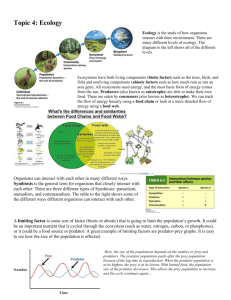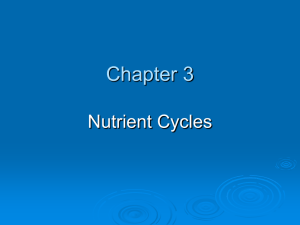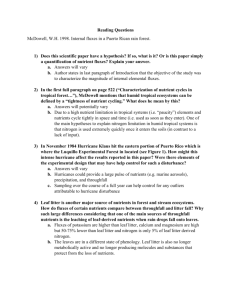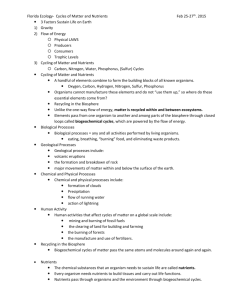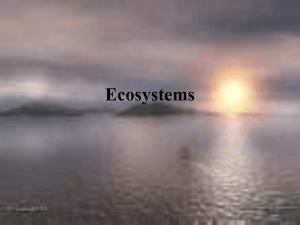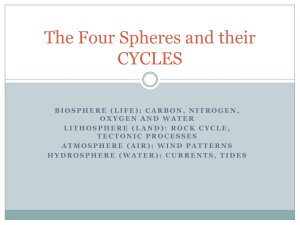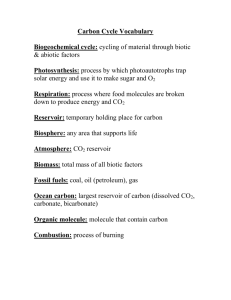3.3 Cycles of Matter
advertisement
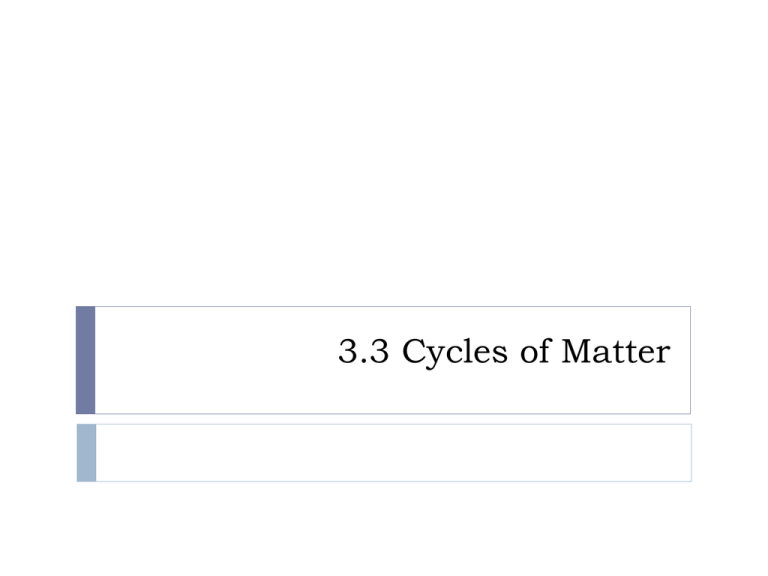
3.3 Cycles of Matter Objectives Describe how matter cycles among the living and nonliving parts of an ecosystem. -------------------------------------------------------------------------- Explain why nutrients are important in living systems. Describe how the availability of nutrients affects the productivity of ecosystems. So Far… We’ve talked about biotic factors of ecosystems…today and tomorrow were going to talk about abiotic factors… What are biotic factors? What are abiotic factors? What are the three most important things you need in order to live??? I once asked this question… What are the three most important things you need in order to live??? The Water Cycle All living things need water to survive. The Water Cycle The Water Cycle Water moves between the ocean, atmosphere, and land through a process called the water cycle. Evaporation – water changes from liquid to gas. Transpiration – water evaporates from leaves. Condensation – water changes from gas to liquid and becomes a cloud. Precipitation – rain, snow, sleet, or hail. Can fall into rivers and be carried to oceans Seep into soil and sucked up by plant roots or become ground water. Assignment - Requirements Create a comic strip about a “drop” of water that goes through the water cycle. The “drop must completely go through the water cycle and hit all seven stages on the diagram on page 75. Evaporation Transpiration Condensation Precipitation Runoff Seepage Root uptake Underline the seven words used. Can be in color…more points given for color!!! Due Friday!!! Assignment Your comic should CAN BE FUNNY AND ORIGINAL!!! Have your droplet go through sewers, drains, oceans, toilets, whatever you want it to go through. Give your water human characteristics such as the ability to talk, facial features, hair, clothes, weapons, anything. Objectives Describe how matter cycles among the living and nonliving parts of an ecosystem. -------------------------------------------------------------------------- Explain why nutrients are important in living systems. Describe how the availability of nutrients affects the productivity of ecosystems. Review What is the autotroph in the following food web? Review What is the autotroph in the following food web? Identify a herbivore in this food web. Identify a carnivore in this food web. Identify a omnivore in this food web. Review What is the shared role of the bacteria, daphnia, and centipede in this food web? Review I’ll give you the definition, you give me the word: The process of going from a liquid to an atmospheric gas. Examples include rain, sleet, hail, and snow. Evaporation from the leaves of plants. The process of water vapor becoming a cloud. Nutrient Cycles Nutrients – chemical substances an organism needs to sustain life. WITHOUT NUTRIENTS YOU WOULDN’T BE ABLE TO CREATE TISSUE (grow) OR CARRY OUT ESSENTIAL LIFE FUNCTIONS. Three Key Nutrients: 1) Carbon 2) Nitrogen 3) Phosphorous The Carbon Cycle (pg. 77) Carbon has many roles: Key ingredient in living tissue. Forms CO Four Process That Move Carbon: 1) Biological process (photosynthesis & respiration) 2) Geochemical processes (volcanic eruptions) 3) Burial and decomposition of dead organisms (or creation of fossil fuel). 4) Human activities (burning fossil fuels, burning forests) The Nitrogen Cycle (pg. 78) All organisms need nitrogen to create proteins. The Nitrogen Cycle (pg. 78) All organisms need nitrogen to create proteins. Nitrogen fixation – process of converting nitrogen gas into usable nitrogen in the soil. Done by special bacteria that live in special roots called legumes. Denitrification – process of converting usable nitrogen into nitrogen gas. Done by plants that take up nitrogen in soil. The Phosphorus Cycle (pg. 79) Essential to living organisms because it forms DNA. Stays in rocks, soils, and dissolved in water. Plants then absorb the usable phosphorus. Nutrient Limitation Sometimes an ecosystem can be lacking in one nutrient, and be unable to support life. Limiting nutrient – ecosystem is limited by a single nutrient that is scarce. Closure Water cycle Carbon cycle Nitrogen cycle Phosphorous cycle Nutrient Limitation QUIZ TOMORROW!!! Assignment To help prepare you for your quiz: Pg. 73 1-5 Pg. 80 1-5

